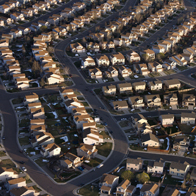
Why Bicycle City?
 Our lifestyles are polluting the earth as at rate that cannot continue unchecked.
Our lifestyles are polluting the earth as at rate that cannot continue unchecked.
Scientists no longer argue about whether the Earth is getting warmer as a result of CO2 emissions; the debate now is the pace of global climate change. Continued depletion of the Earth’s non-renewable energy resources accelerates the pace. In the United States, motorized vehicles consume 16% of all energy used and contribute 33% of CO2 emissions into the air. They also contribute to noise and water pollution and add to landfill. (Source: Bikes at Work: Some Facts on Automobiles and the Environment) 
In the United States, buildings — commercial and residential — account for 39% of energy use and 38% of CO2 emissions. Building materials and methods exist that will change those numbers. Today, consumers want a home that is designed with the surrounding land and community in mind. By adopting green building strategies, and vastly decreasing daily use of automobiles, we can make a measurable difference in energy consumption and also in the health of the planet. (Source: EPA: Why Build Green)
For the sake of physical and financial health, lifestyle changes are needed.
 In the United States, obesity and physical inactivity are shortening life spans and are listed among the leading causes of preventable death. The design of our cities and communities, which focuses more on cars than on people, often precludes the opportunity to get exercise by walking or biking from home to school, work, shopping, etc. In just one generation, the number of children who walk to school has declined by 70%. During that time childhood obesity has tripled. (Source: Bikes Belong: Fast Facts)
In the United States, obesity and physical inactivity are shortening life spans and are listed among the leading causes of preventable death. The design of our cities and communities, which focuses more on cars than on people, often precludes the opportunity to get exercise by walking or biking from home to school, work, shopping, etc. In just one generation, the number of children who walk to school has declined by 70%. During that time childhood obesity has tripled. (Source: Bikes Belong: Fast Facts) 
From a financial perspective, the average U.S. family spends $7,830 ($9,990 if it’s an SUV) per year to drive 15,000 miles. With real median household income at $48,200, that’s 16% of annual income spent on loan or lease payments, insurance payments, maintenance fees, registration, taxes and fuel. The rising cost of fuel impacts those numbers daily. In 2006, 38% of American homes had two vehicles and another 20 % had three or more. It costs roughly $120 a year to maintain a bike. (Sources: US Census News Bureau: Household Income Rises, Poverty Rate Declines, Number of Uninsured Up; AAA Newsroom: Crashes vs. Congestion - What's the Cost to Society?; US Census Bureau American Fact Finder)
Is there a market? Yes
There are people who don’t want to spend 66 minutes, per day, on average, sitting in a car, traveling from one place to another – work, school, shopping - just about everywhere. A March 2008 poll by Harris Interactive* revealed that two-thirds of US adults were at least somewhat interested in living in Bicycle City, while one-in-six indicated they were very interested in living in Bicycle City. The most attractive aspects of the community to respondents were the active and healthy lifestyle, reduced energy consumption, sense of community and close proximity to shops, community areas and restaurants, and the lack of smog. More than half of the respondents cited the “opportunity to live a lifestyle that results in less impact on the Earth.” It is clear that people want affordable homes that are designed with the most efficient methods and materials to minimize its impact on the land, air and water. They want their home to be surrounded by a community designed to foster an active, earth-friendly lifestyle.
Bicycle City is a unique solution to the market need for eco-friendly homes within a community designed to support an active lifestyle.
Everywhere you look today you see news reports and articles with predictions of dramatic changes to the global climate, changes that will affect the way everyone lives. Every day there are new films, articles and magazine covers dedicated to climate change. Television stations dedicate entire weeks to raising awareness of the environment. A search on Google for “global warming” results in almost 23 million hits.
The issue surrounds us. It makes us think about the way we live.
People are aware and interested in learning more about what they can do to lessen their impact on the Earth. Many people are taking actions – small changes in many areas of their lives – what they eat and how they get around - for their health and for the health of the Earth, but experts agree that more significant changes will be needed.
Christopher B. Leinberger, a land use strategist and developer, and a Visiting Fellow at the Brookings Institution in Washington, DC, says, “There are many segments of the population that want something different; what can be broadly called “walkable urbanism… There is pent-up market demand for the alternative to drivable sub-urbanism that is readily apparent.” Recent consumer research by Jonathan Levine of the University of Michigan and Lawrence Frank of the University of British Columbia suggests that roughly one in three homeowners would prefer to live in walkable, urban places. (Source: Christopher B. Leinberger Website; The Atlantic: The Next Slum?)
Alex Steffen, executive editor of WorldChanging, the most widely-read sustainability-related publication on the Internet, writes, “...we most need to adopt one solution that leverages almost all the others: stop sprawl and build well-designed compact communities. …That's because the land-use patterns in our communities dictate not only how much we drive, but how sustainable we're able to be on all sort of fronts. In other words, there is a direct relationship between the kinds of places we live, the transportation choices we have, and how much we drive. The best car-related innovation we have is not to improve the car, but eliminate the need to drive it everywhere we go.”
Imagine if all those little steps that so many people are taking could be magnified to create a place where all the best ways that we know to live healthier are combined. We will have a city of high-density living, mixed with commercial tenants – restaurants, service professionals, retail, artists — designed to allow people to walk or ride bikes to take care of their daily errands and appointments. Active, engaged residents will continue to improve the community, supporting art and music, managing local farming and working toward sustainable energy sources. All around the town center will be acres of undeveloped land. Beautiful vistas, creeks, lakes. Residents will bike, hike and explore. Visitors will come to experience Bicycle City. Some of them will come back to stay.
Local Resources — Sustaining Bicycle City
Bicycle City will attract people who are committed to reducing chemicals from their lives — from the food they eat and the air they breathe. These same people will appreciate that the organic farm at Bicycle City doesn’t contribute to the pollution of local water or harm the neighboring wildlife. The farm at Bicycle City will not only attract residents who both want to eat the produce and grow it – that is, work on the farm – the successful implementation of the farm will bring revenue and jobs to the community. The U.S. organic food market rose to $16.7 billion in 2006. Organic food is available in many conventional supermarkets today, and although it may cost more, consumers are willing to pay for it.
Conclusion
Of the 6 billion people living in the world, there are five to ten thousand who will choose to change the way they live, and if the option is available, they will make an active choice to protect their own health, the health of their families and the health of the Earth.
* This survey was conducted online within the United States by Harris Interactive on behalf of Bicycle City LLC between March 11 – March 13, 2008 among 2,920 U.S. adults. Results were weighted as needed for age, sex, race/ethnicity, education, region and household income. Propensity score weighting was also used to adjust for respondents’ propensity to be online. No estimates of theoretical sampling error can be calculated; a full methodology is available.
Harris Interactive is a global leader in custom market research. With a long and rich history in multimodal research that is powered by our science and technology, we assist clients in achieving business results. Harris Interactive serves clients globally through our North American, European and Asian offices and a network of independent market research firms. For more information, please visit HarrisInteractive.com.